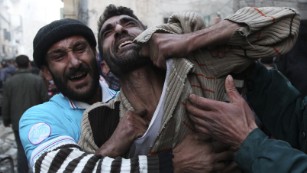Washington – The U.S. intelligence community now thinks Russia may have embarked on its military buildup in Syria because Moscow believes Syrian President Bashar al-Assad may not be able to hang onto power and it wants to position itself to back a proxy if the regime were to collapse. It is a view shared by the Pentagon, Defense officials told CNN.
This is one theory, but there is not a firm conclusion within the Obama administration about why Russian President Vladimir Putin is sending aircraft, tanks and missiles into the wartorn country, several senior U.S. officials told CNN.
On Monday on the sidelines of the United Nations, President Barack Obama is scheduled to meet with Putin for the first time in nearly a year to discuss the latter’s plans in Syria.
Russian fighter jets enter Syria with transponders off
If the Russians assure the United States that they are planning only to fight ISIS and not prop up ally al-Assad, that could lead to a new round of bilateral discussions on how to avoid military mishaps as both countries have forces operating there.
The Russians have not been clear about whether they will join the U.S.-led fight against ISIS or prop up al-Assad — which the United States objects to, as America has declared the Syrian leader must go.
The meeting comes as the United States is watching initial intelligence indicators that the Russians also may be setting up some type of operation in Baghdad to coordinate their efforts with Iraqi, Iranian and even Syrian elements.
Iraq has denied any such operation, but several U.S. officials told CNN they believe a coordination effort is being assembled, though its mission and status remain unclear. Fox News first reported the development.
Pentagon waiting on White House
Military and defense officials told CNN that after the Obama-Putin meeting, they are hoping the Obama administration will quickly make some decisions about U.S. cooperation with rebels in northern Syria, because they see a rare opportunity that could easily be missed.
“We have the ability to do serious damage,” the official said, adding that key U.S. commanders are anxious to see the White House make decisions about the way ahead. Another senior U.S. military official expressed frustration that those decisions have not already been made.

Among them are whether to supply Syrian rebels with ammunition and how to adjust the train-and-equip program of Syrian rebels, which is now largely deemed a failure.
U.S. intelligence still sees al-Assad’s collapse as likely to be several months away, though he has been considerably weakened over this year after losing of significant territory and directing an army that is increasingly demoralized.
The United States is trying to assess whether figures in Syria still exist who might be able to step in should al-Assad fall, a senior U.S. official told CNN, but for now doesn’t see a clear leader or dissident who could garner enough support inside Syria to take power.
The United States is concerned about the preservation of basic social structures and services that still exist in Damascus should al-Assad fall, since the regime’s implosion could open the door to a humanitarian disaster if ISIS or al Qaeda-affiliated militias were to move in.
Preserving Damascus is seen as so critical to the potential rebuilding of Syria that the United States wants to ensure the Russian military does not destroy key infrastructure in any future bombing campaign.
U.S. officials said that for now no Russian combat flights have begun, but that that could change at any time.
Military sees opening in northern Syria
In the meantime, the United States sees possibilities for making progress in the fight against ISIS in the north and wants White House backing to move ahead.
A defense official explained, “The conflict has morphed into a position where an opportunity presents itself to our advantage to defeat ISIS in northern Syria. There are options developed to leverage those opportunities.”
One key option needing White House approval is whether to provide ammunition for the so-called Syrian Arab Coalition — a loosely affiliated group of fighters and militias in the region — along with Syrian Kurds, who have had recent success in pushing back ISIS, especially from the Turkish border, which it uses to bring in foreign fighters.
Another decision to be made is exactly how the U.S. military will now train and equip moderate Syrian rebels as part of the broad Pentagon program.
The current proposal is to get White House approval to pull back from training those rebels in Turkey and Jordan as a combat force and focus instead on having them trained to help provide intelligence and communications.
The goal is to continue to stop the flow of foreign fighters and also cut off ISIS resupply lines from Syria into northern Iraq. But cutting off those lines will be difficult.
Col. Patrick Ryder, spokesman for U.S. Central Command, told reporters Friday that ISIS still retains some “freedom of movement” in eastern and southern Syria. Those are key areas for those supply routes.
Two officials told CNN there was a brief discussion inside the Pentagon about whether there was any benefit to sending a small number of U.S. troops into northern Syria to help with these efforts, but it was quickly rejected as unnecessary because of the success of other forces there. Officials insisted the idea is not considered to be a serious option.
Despite the opportunities presenting themselves in Syria and successful strikes against leadership there, whether progress can be made inside Iraq remains an open question. Ryder noted that Iraqi forces have not made any real forward progress in retaking Ramadi nearly four months after it fell and are being urged to do so by the United States.
As reported by CNN
